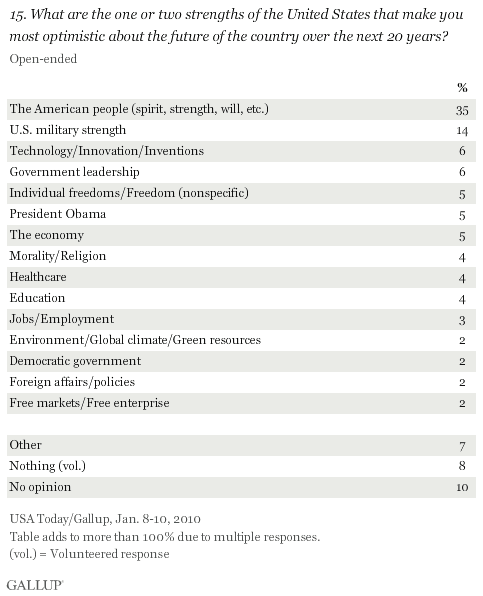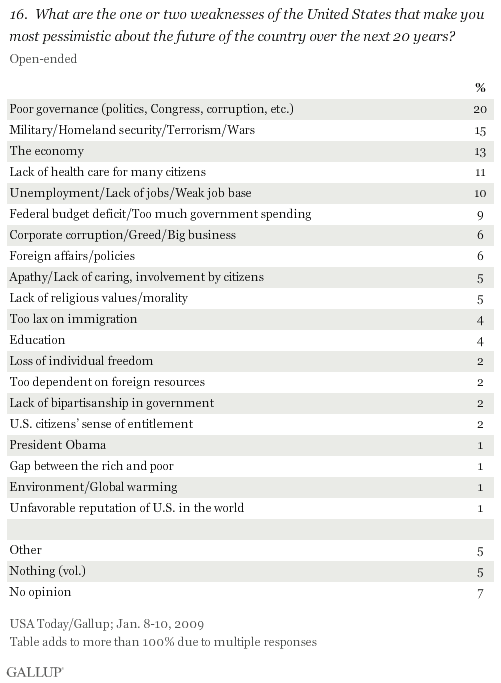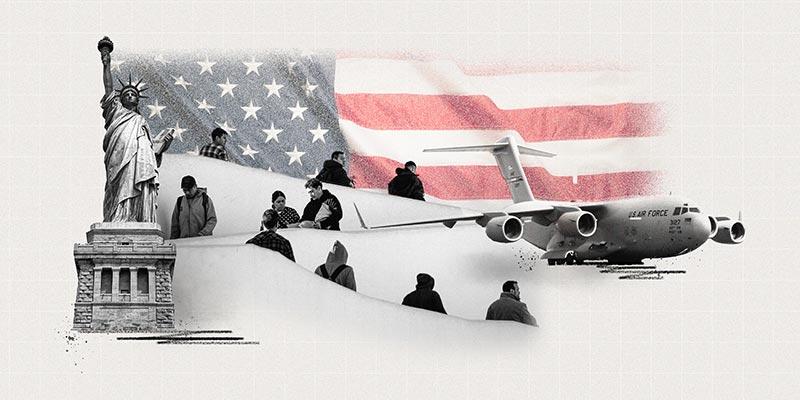PRINCETON, NJ -- Americans were asked in a recent USA Today/”≈√€¥´√Ωsurvey to name the one or two strengths of the United States that make them feel most optimistic about the future of the country and, conversely, the main weaknesses that make them the most pessimistic. The American people themselves, named by 35%, and the nation's military (14%) dominate the list of perceived strengths.
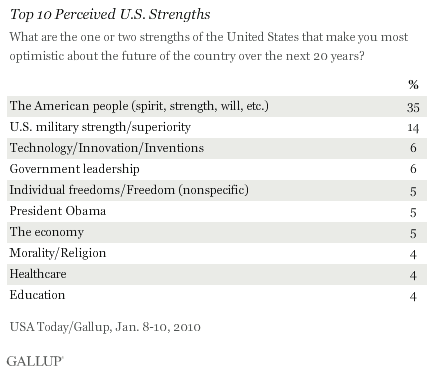
The "American people" category includes a number of basic qualities that Americans cite in response to this question: their spirit, optimism, strength, will, resilience, cohesiveness, patriotism, and diversity. However, many of those citing Americans as the nation's top strength simply say "the American people."
Other strengths in the top 10 include U.S. technology and innovation (6%), freedom (5%), and the economy (5%). At least 5% of Americans also mention government leadership generally, and President Obama specifically.
Poor governance -- including "politics," poor leadership, Congress, corruption, and inefficiency -- ranks as the leading weakness that Americans say makes them feel the most pessimistic about the country's future. Twenty percent of Americans mention this. Other factors named by at least 10% are the military -- including involvement in wars and vulnerability to terrorism (15%) -- the economy (13%), lack of healthcare (11%), and lack of jobs (10%).

Slight Generational and Partisan Differences
While the rank order of perceived strengths is roughly similar for Americans of different ages and political leanings, there are a few notable differences in degree.
Mentions of the American people as a national strength are more prevalent among Americans aged 35 to 54 (42%) and 55 and older (35%) than among those aged 18 to 34 (23%).
The main differences among the parties in perceptions of U.S. strengths are a lower relative percentage of Democrats mentioning the American people, a higher percentage of Republicans mentioning the military and homeland security, and a higher percentage of Democrats mentioning President Obama.

In terms of perceived weaknesses of the country, government corruption ranks as the top weakness for middle-aged (19%) and older (24%) Americans, but ties for third among younger adults (at 12%). While the military/homeland security receives about equal mentions from all three age groups, it is the top-mentioned U.S. weakness among those 18 to 34. Older Americans are more likely than young adults to perceive a lack of religion and morals as a key national weakness.
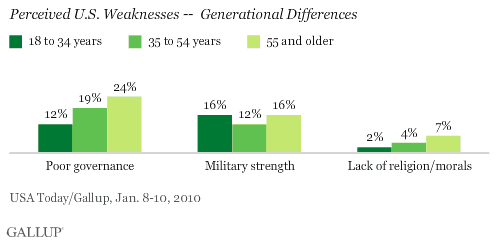
While equal percentages of Republicans, independents, and Democrats cite government as a top U.S. weakness, Republicans (20%) are more likely than independents (11%) and Democrats (14%) to cite problems with the military and homeland security. They are less likely than Democrats to cite public apathy (2% vs. 7%, respectively).
Bottom Line
Americans are most likely to consider the qualities of the common people to be the nation's best hope for the future. The 35% citing the spirit and will of Americans as a national strength far outweighs the 5% citing Americans' apathy as a national weakness. The military is more of a double-edged sword: 14% cite the nation's military strength and superiority as a national strength, but 15% cite military unpreparedness, lack of security from terrorism, and involvement in wars as a national weakness. While a small segment of Americans (5%) believe the government in general is a key strength -- and an additional 5% cite President Obama as a strength specifically -- 20% see poor leadership in government as one of the country's leading weaknesses, with an additional 9% citing the federal budget deficit.
Survey Methods
Results are based on telephone interviews with a random sample of 1,023 national adults, aged 18 and older, conducted Jan. 8-10, 2010. For results based on the total sample of national adults, one can say with 95% confidence that the maximum margin of sampling error is ±4 percentage points.
Interviews are conducted with respondents on land-line telephones (for respondents with a land-line telephone) and cellular phones (for respondents who are cell-phone only).
In addition to sampling error, question wording and practical difficulties in conducting surveys can introduce error or bias into the findings of public opinion polls.
